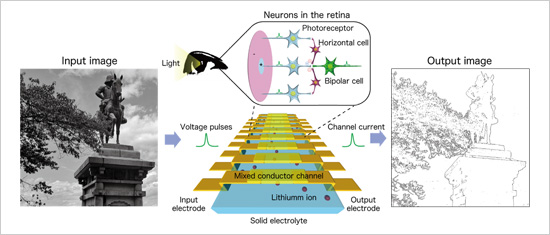Development of an Artificial Vision Device Capable of Mimicking Human Optical Illusions
—Device May Enable Image Processing Without Requiring Software—
2021.10.11
National Institute for Materials Science (NIMS)
NIMS has developed an ionic artificial vision device capable of increasing the edge contrast between the darker and lighter areas of an mage in a manner similar to that of human vision.
Abstract
- NIMS has developed an ionic artificial vision device capable of increasing the edge contrast between the darker and lighter areas of an mage in a manner similar to that of human vision. This first-ever synthetic mimicry of human optical illusions was achieved using ionic migration and interaction within solids. It may be possible to use the device to develop compact, energy-efficient visual sensing and image processing hardware systems capable of processing analog signals.
- Numerous artificial intelligence (AI) systems developers have recently shown a great deal of interest in research on various sensors and analog information processing systems inspired by human sensory mechanisms. Most AI systems on which research is being conducted require sophisticated software/programs and complex circuit configurations, including custom-designed processing modules equipped with arithmetic circuits and memory. These systems have disadvantages, however, in that they are large and consume a great deal of power.
- The NIMS research team recently developed an ionic artificial vision device composed of an array of mixed conductor channels placed on a solid electrolyte at regular intervals. This device simulates the way in which human retinal neurons (i.e., photoreceptors, horizontal cells and bipolar cells) process visual signals by responding to input voltage pulses (equivalent to electrical signals from photoreceptors). This causes ions within the solid electrolyte (equivalent to a horizontal cell) to migrate across the mixed conductor channels, which then changes the output channel current (equivalent to a bipolar cell response). By employing such steps, the device, independent of software, was able to process input image signals and produce an output image with increased edge contrast between darker and lighter areas in a manner similar to the way in which the human visual system can increase edge contrast between different colors and shapes by means of visual lateral inhibition.
- The human eye produces various optical illusions associated with tilt angle, size, color and movement, in addition to darkness/lightness, and this process is believed to play a crucial role in the visual identification of different objects. The ionic artificial vision device described here may potentially be used to reproduce these other types of optical illusions. The research team involved hopes to develop visual sensing systems capable of performing human retinal functions by integrating the subject device with other components, including photoreceptor circuits.
- This project was carried out by a research team consisting of Tohru Tsuruoka (Chief Researcher, Nanoionic Devices Group (NDG), International Center for Materials Nanoarchitectonics (MANA), NIMS), Xiang Wan (Postdoctoral Researcher, NDG, MANA, NIMS at the time of this project) and Kazuya Terabe (Group Leader, NDG, MANA, NIMS).
This research was published in the online version of Nano Letters, an American Chemical Society journal, on September 14, 2021, Japan Time.

Figure. Ionic artificial vision device (center), in which lithium ions migrate and interact, mimics the way in which human retinal neurons process visual signals. Processing of the input image (left) resulted in production of the output image (right) with increased edge contrast.
Related files
- International Center for Materials Nanoarchitectonics (MANA)
Contact information
(Regarding this research)
-
Tohru Tsuruoka
Chief Researcher
Nanoionic Devices Group
Nano-System Field
International Center for Materials Nanoarchitectonics
National Institute for Materials Science
Tel: +81-29-860-4117
E-Mail: TSURUOKA.Tohru=nims.go.jp
(Please change "=" to "@") -
Kazuya Terabe
Group Leader
Nanoionic Devices Group
Nano-System Field
International Center for Materials Nanoarchitectonics
National Institute for Materials Science
Tel: +81-29-860-4383
E-Mail: TERABE.Kazuya=nims.go.jp
(Please change "=" to "@")
(General information)
-
Public Relations Office
National Institute for Materials Science
Tel: +81-29-859-2026
Fax: +81-29-859-2017
E-Mail: pressrelease=ml.nims.go.jp
(Please change "=" to "@")
Recent Press Release
-
Simultaneous Imaging of Intracellular DNA and RNA Using Harmless Light
2025.10.27
-
Development of an AI Device Using Ion Gel and Graphene That Dramatically Streamlines Machine Learning Computations
2025.10.14
-
Demonstrating a Novel Method to Modulate Heat Flow Through the Collective Motion of Spins
2025.10.06
